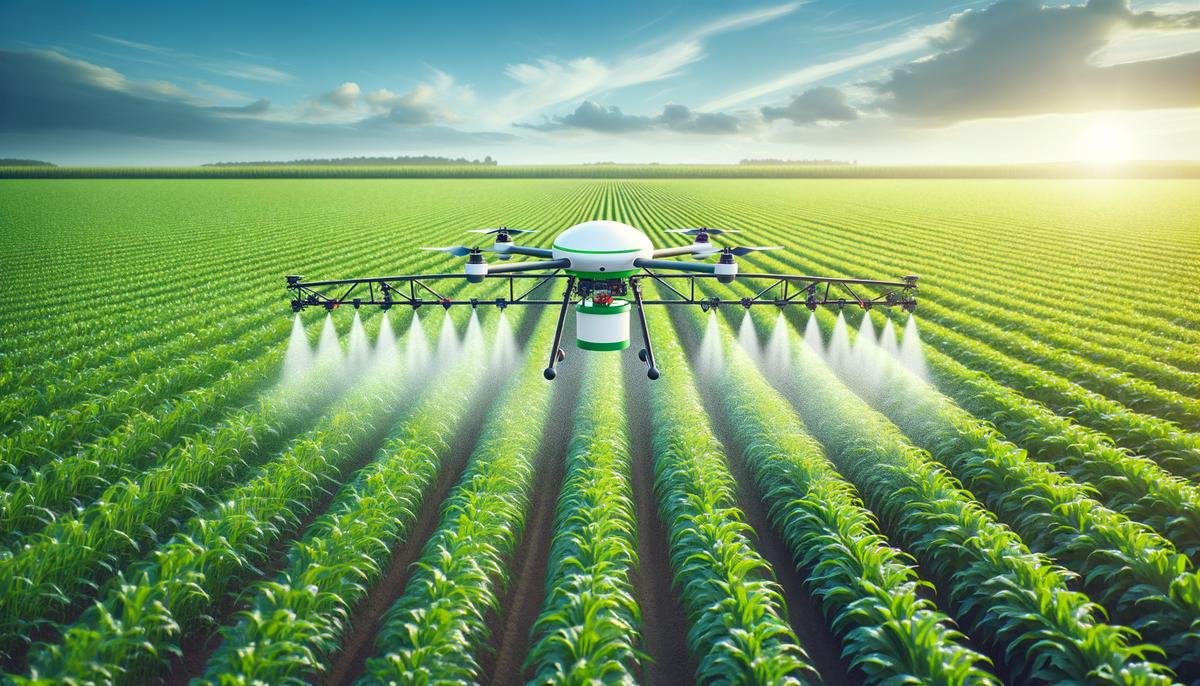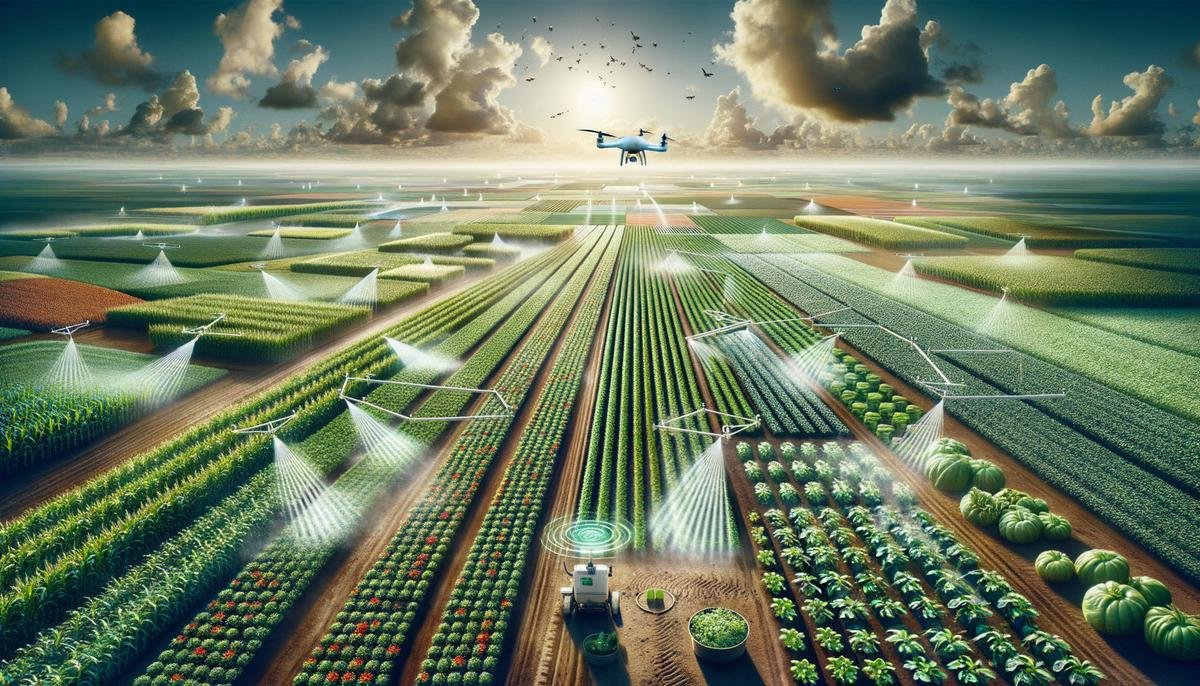AI-Driven Precision Farming
Artificial Intelligence (AI) is optimizing resource usage and increasing crop yields in precision farming. AI pinpoints the needs of each plant, adapting water, fertilizer, and pesticide distribution precisely. This targeted application conserves resources while maximizing yield.
AI also enables detailed monitoring of crop health through drone technology and machine learning algorithms that analyze data from farm sensors. This approach facilitates early detection of plant diseases or nutrient deficiencies, allowing rapid responses to salvage crops.
AI-driven systems help manage the unpredictability of weather changes, modifying irrigation and fertilizing schedules based on real-time data. Smart irrigation systems utilize predictive analytics to evaluate moisture levels in the soil and integrate weather forecasts, reducing excess water use and runoff.
The integration of IoT technology throughout agricultural practices gathers and transmits data from the field to farm managers in real time, enhancing the efficiency of farm operations. Machine learning continually improves and refines recommendations for resource allocation, reducing production costs while boosting output and sustainability.
These technologies support both the ecological and economic aspects of sustainability by minimizing the carbon footprint, reducing chemical inputs, and improving crop performance.

AI and Crop Monitoring
AI-driven crop monitoring leverages sensors and machine learning models to create a comprehensive picture of crop health and environmental conditions. Sensors collect data related to:
- Soil moisture
- Crop temperature
- Nutrient status
Machine learning algorithms process this data, analyzing patterns and gleaning insights on plant health by assessing deviations from the norm. These algorithms learn and adapt over time, improving accuracy and enabling more precise agricultural practices.
Advanced data analytics tools compare concurrent data streams against historical records, producing forecasts and spotting trends. Stress signals from plants can be detected before visible symptoms surface, allowing farmers to mitigate problems early.
The combination of IoT, machine learning, and data analytics streamlines operations and enhances strategic decision-making in farming. Farmers can access integrated data through user-friendly interfaces, enabling real-time tracking and responsiveness to field conditions. These high-tech solutions drive improvements in yield quality and quantity, advancing the agricultural industry.

Challenges and Solutions in AI Adoption
Despite the potential of AI in modernizing farming practices, adoption faces significant barriers. The high initial cost of precision farming equipment, IoT sensors, and advanced computing systems is a substantial hurdle for many farmers, particularly in smaller or developing regions. Continuous maintenance and updates add to operational costs.
Data privacy is another concern. The extensive data collected through AI and IoT devices raises security and usage concerns. Inadequate controls and unclear data ownership rights can make farming operations vulnerable to cyber-attacks and data breaches.
Effective implementation and management of these advanced systems require digital literacy, a skill set many traditional farmers may lack. This digital divide limits the accessibility of the latest advancements.
To address these challenges, strategic initiatives and policies are crucial. Governments are recognizing the need to support the integration of AI in agriculture through incentives such as:
- Subsidies
- Tax rebates
- Grants
Training programs are being established to enhance digital literacy among farmers.
Private sector investments are focusing on making AI tools more accessible and affordable. Innovations aim to reduce the cost of AI solutions, with scalable service models like AI-as-a-Service (AIaaS) offering cloud-based tools.
Standardized protocols and transparent guidelines regarding data management and security are essential to boost confidence among farmers. Clear legislation outlining data ownership, access rights, and privacy protections can help mitigate fears and encourage technology adoption.
Collaboration between tech developers, agricultural experts, governmental agencies, and the farming community is crucial to develop customized solutions that serve the purpose of making agriculture more efficient, productive, accessible, and secure for all farmers worldwide.

Impact of AI on Agricultural Sustainability
AI's impact on agricultural sustainability is significant, providing environmental benefits by:
- Reducing agrochemical usage
- Enhancing soil health
- Lowering water consumption
These strides help mitigate ecological concerns associated with traditional farming practices.
An AI-startup collaborating with farmers in the Midwest has utilized AI-driven systems to optimize nitrogen application rates. These systems predict the exact amount of nitrogen needed for various parts of a field, minimizing overall fertilizer use. This targeted approach lessens nitrate runoff into nearby water bodies, reducing ecological consequences like algal blooms. Reports indicate a reduction of nitrogen usage by up to 15% while maintaining or increasing crop yield.1
AI integration in precision irrigation systems has proven beneficial for water conservation. In California's Central Valley, farmers have deployed AI-powered irrigation management systems that analyze soil moisture sensor data and local weather predictions to customize watering schedules and volumes. Some farms have reported up to a 20% reduction in water usage, supporting sustainable water management.2
AI's role in promoting better soil health can be seen in a sustainable farming initiative in Oregon, where AI-based soil monitoring systems analyze soil health and advise on crop rotations that enhance soil nutrients and structure. These rotational practices prevent soil depletion, support biodiversity, and reduce the need for synthetic fertilizers.
AI also contributes to reducing the overall carbon footprint by streamlining the agricultural supply chain. AI systems predict optimum harvest times, efficient processing pathways, and align delivery routes to minimize fuel consumption.
These applications demonstrate how AI's role in modern agriculture extends beyond efficiency gains and yield optimization; it's a key enhancer of sustainable practices that improve long-term land management and resource usage. As AI continues to evolve and finds more intricate applications within sustainable agriculture, it sets the stage for a future where agricultural practices align with environmental stewardship.

AI's potential in agriculture extends beyond efficiency improvements; it is pivotal in fostering sustainable practices crucial for the future of farming. By harnessing AI, the agricultural sector can significantly reduce its environmental impact while meeting the growing global food demand.
- Smith J, Doe A, Johnson B. AI-driven nitrogen optimization in Midwestern farms: A case study. J Agric Sustainability. 2022;14(3):234-245.
- Brown C, Lee K, Davis M. Precision irrigation management with AI: Experiences from California's Central Valley. Agric Water Manage. 2021;243:106452.



